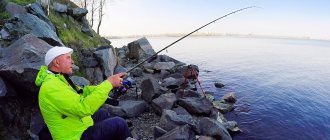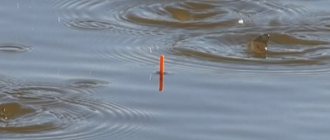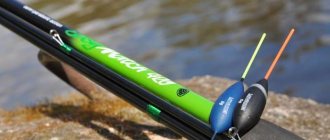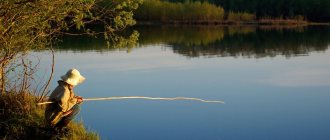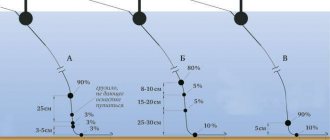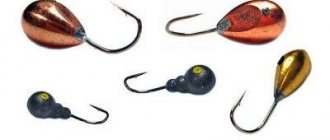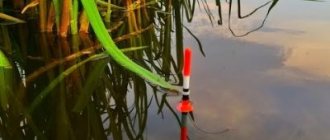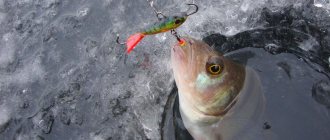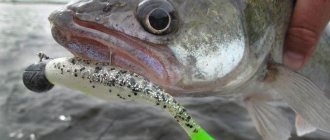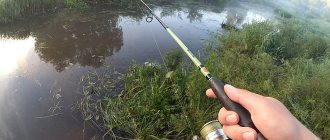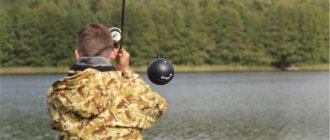A float rod is used when fishing for white fish and in some cases when fishing for predatory fish, especially when using live bait as bait. A novice fisherman always faces a dilemma:
- Buy a ready-made fishing rod complete with all the gear.
- Or buy a rod, fishing line, float, hooks, and a set of lead pellets in the store and assemble the tackle yourself.
Both methods have a right to life, moreover, a store-bought ready-made fishing rod will be even more preferable for anglers who need quick results, and attention to detail takes a back seat. And for anglers who want to gain true mastery of the tackle and achieve a deep understanding of float fishing with a fly rod, this step-by-step guide has been written.
Types of float rods
The rod for a float rod should be longer the further you plan to cast the float rig.
Fishing rods are:
- fly - the nozzle and float are delivered to the fishing spot with a small wave of the hand, the reel is not involved in fishing;
- Plug rods are used for fishing in distant areas from the shore. The rod consists of several composite plugs, which, when connected, make the rod very long, which allows you to deliver the bait and float located a couple of meters from the tip of the rod directly to the fishing spot;
- match fishing rods consist of a spinning reel and equipment with a sliding float. Match equipment can be cast using the spinning method over long distances, and the sliding float allows you to fish even in very deep places.
The weight of the fishing rod depends on the fish we plan to catch. Fishing rods that can be placed on a stand can be heavier, while spinning rods can be as light as possible. We divide fishing rods into three types: telescopic, solid and segmented. The telescope unfolds, pulling out the following elements hidden one inside the other. Segmented ones can consist of two, three or four parts. Solids, as the name suggests, are made of one piece and are the strongest of all types.
Rods and their equipment
Before we start looking at the types of fishing rods, let's talk about the different forms available on the modern fishing market. It is the rods that become the basis of the tackle on which the superstructure – the equipment – is mounted. Types of rods used for fishing:
- spinning rods;
- telescopes;
- plugs;
- feeders;
- cyprinids;
- fly fishing
Spinning rods Spinning rods are blanks up to three meters long, designed to be equipped with any type of reel. Depending on the tasks assigned, they can be equipped with equipment for the following types of fishing:
- actually spinning;
- trolling;
- vertical fishing from a floating device;
- bottom fishing.
Spinning rods for the most part have small test values, which allows them to be used for long-distance casting of light baits. At the same time, some marine models have a significant power reserve. Attention! A special category is represented by Chinese crocodile-type spinning rods. They are mainly used to create folk donks.
A Chinese-made spinning rod in this example is the basis of the bottom tackle. The overwhelming majority of spinning rods have a plug connection, but there are also telescopic models. They are mainly used as tourist fishing rods due to their compactness for transportation. Telescopes Telescopic rods vary in size, number of legs and arrangement of rings. Depending on this, they receive the appropriate equipment. Apart from float fishing, I use short three-meter telescopes for vertical fishing from boats and as a basis for hooks. Four-meter forms are the most versatile. They are suitable for equipment for the following types of fishing rods:
- Bolognese float;
- match;
- live bait for catching predators;
- for fishing with a side nod;
- for donk equipment.
Fishing rods from five meters and longer are used to construct fly-float gear; it is difficult to use them in any other capacity due to their large dimensions and weight. Such models may not even have access rings, and their equipment is attached to a special connector located at the tip of the whip.
To attach the fishing line loop, the connector sleeve is moved down and then pushed back. Plugs The plug connection of the elbows gives the blank greater strength, precise ring placement, elegance and functionality. Therefore, more and more modern fishing rods are produced in this design. Most often their length is about four meters. This allows them to be used to create the same fishing rods that we discussed above for universal telescopes. Separately, it is necessary to say about the float plugs. This is a complex combined fishing rod of great length, sometimes reaching fifteen meters. The basis of such a rod is a set of elbows connected by a plug method. Unlike other gear, this fishing rod is not lifted above the water entirely.
Source
Choosing a fly rod for float fishing
We will focus on a fly fishing rod, because in most cases it is enough to fish a large area of water, and its use does not impose any additional inconvenience.
Interestingly, the fly fishing method is positioned as humane. As a rule, caught individuals are simply released. This is why you can often find barbless hooks, which are the most gentle on fish.
When looking for the perfect fishing rod, there are many things to consider. The quality of equipment greatly influences comfort and freedom of movement. You should also remember that not only the fishing rod is important. Fly fishing requires the angler to fish with greater dedication, often wading into waist-deep water. It is also important to have specialized clothing.
The length of the rod is usually from 4 to 6 meters. The longer the rod, the heavier it is, and lightness is very important in fly tackle. Therefore, at the initial stage it is recommended to take a fishing rod no longer than 5 meters; this length will be enough for you to make even fairly long casts.
The vast majority of fly rods are telescopic, but try to choose rods made from lightweight materials.
Recently, carbon fishing rods have become popular, combining strength and lightness.
Fly fishing also requires a special reel that fits under the handle of the rod. This method uses lightweight models of simple design (no more than 180 g). An important element of the reel is an adjustable brake (friction or ratchet), which prevents the line from slipping out during casting.
The presence of a reel is welcome, but many models are sold even without reel mounts. These options use special reels, which are needed only to reel in the fishing line after fishing and to transport the fishing rod. In this case, the reel itself does not participate in fishing and is not on the fishing rod.
The lack of a reel makes the rig easier, but less convenient if you need to make longer casts. Therefore, whether to use a simple reel or not is up to you.
Inertia-free reels for a float fly rod are completely optional, and even less preferable for fishing with a float rod. They are unnecessarily heavy and do not provide useful functions for a fly rod. Constant winding and winding of the fishing line is not required here.
The tip of the rod should be quite sensitive so that during hooking it makes a sharp hook (not too hard), otherwise you can tear off the fish’s lip or not hook it at all.
Deciding on the fishing rod manufacturer
Decide in advance what you need - a guarantee of quality and high consumer properties from world brands at a high price, or a reasonable price from a little-known manufacturer.
Well-known manufacturers of fishing tackle offer a wide range of fishing rods at a considerable price. But the choice of fishing rods with a lower price is not so wide, they are all similar to each other, and the bright labels on them are just decoration, you shouldn’t believe them. But even among them you can pick up a pretty decent fishing rod with good quality; such a specimen will cost you about ten dollars. If you buy a fishing rod cheaper, then you risk buying something unknown that is unsuitable for fishing.
If this is your first time choosing a fishing rod, then ask an experienced fisherman for help, he will tell you how to choose the right fishing rod for summer fishing and winter fishing of good quality.
Float rod equipment
The float rod equipment looks like this:
1. Two small pieces of cambric are strung onto the main line , into which the tip of the float and its lower part are then inserted. Some floats have a ring in the upper part, so the line is threaded through the ring, and the lower part is secured with a cambric (in this case, only 1 cambric is needed).
2. Next comes a series of lead pellets to load the float. The pellets come with a hole and a notch on the side. In both cases, the pellet is applied or strung on a fishing line and clamped with pliers (or teeth).
Attention: it is highly recommended not to press pellets with your teeth, and especially to try to bite off an excessive part of the pellet in order to reduce its weight. This leads to damage to the integrity of the tooth enamel; use small forceps or pliers for this purpose.
There should be several sinkers and their size should decrease as the fishing line approaches the hook.
3. The very last sinker should be moved away from the penultimate one by 7-10 centimeters and be the smallest. This sinker is called a sub-sink. It contributes to the correct distribution of the weight of the equipment and will allow you to load the leading part of the equipment.
4. After the sub-grazing, there is a connection between the main line and the lead line. The lead line has a smaller diameter than the main line. For example, if the main line has a diameter of 0.18, then the leader line can be set to 0.12. But be careful, a large fish can break off a fishing line that is too thin and of poor quality. The diameter of the leash should not be thinner than 0.15.
The leash is used so that the fish is not afraid of the fishing line and if your hook gets caught on the bottom (snag, stones) and with small twitches you will not be able to unhook it - you would pull the fishing line with your hands stronger and break the tackle exactly in the leash (where the line is thinnest). This way you will only lose the hook, which is much easier to cope with than losing the float.
Use the correct knot to attach the leash.
5. Finally, a hook is attached to the leash. The length of the leash should be about 10 cm. The hook must be secured with a special knot for reliability.
Loading the float
Proper loading of the float surrounds it so that only its antenna is visible above the surface of the water.
This load allows you to make the equipment very sensitive to even the weakest touches of the fish on the bait. In windy weather, it is advisable to make the equipment a little less sensitive so that the waves do not completely cover the float, although in this case the bite can be distinguished (when the float does not appear from under the water for a second, or emerges from it).
The float can be loaded directly at home in a 1.5-2 liter plastic bottle. First attaching a larger lead pellet, and then smaller and smaller ones, until the float is located at the bottom of the antenna. If you have overloaded the float too much, you can cut off part of the pellets with pliers or scissors. It is not advisable to do this with your teeth.
Video of float fishing for crucian carp - how to choose a place, prepare bait, the process of fishing with a float.
Fishing hook sizes - international and Soviet numbering, comparison.
The choice of fishing line depending on the gear used
- for fishing in snags, from the bottom, in peat quarries, a brown line is suitable; - for fishing in thickets of grass, a line of greenish-brown or light green color will be less noticeable to fish.
Recently, “dotted” fishing lines have been widely used. Light parts on them alternate with parts painted in multi-colored dark tones. Parts of such a fishing line, depending on the illumination of the water column, are hardly noticeable against the background of the bottom, vegetation or underwater objects.
Fly tackle has been and remains an ageless classic of fishing. Among the main advantages of the fishing rod, experts note the simplicity of equipment, the ease of casting equipment and the fast pace of fishing.
Fishing for crucian carp with a fly rod is most often carried out in the windows of coastal vegetation, on river oxbows and from boats. The length of the fishing line with equipment should exceed the length of the rod by cm.
Crucian carp do not always feed near the coastline. When fish are hiding in the depths away from the shore, long-range tackle is required.
In short, it is a necessary and necessary thing.
Proper rigging of a float rod
The weight is written on each float and set of sinkers, so loading accordingly is not a problem. Actually, the choice here is not as great as with other equipment.
For fishing with a float, olives and pellets. It is better to place not one large pellet, but several small pellets on the float rig.
Then, when casting the equipment, there will be no loud splash, which will scare away all the fish. When fishing in a current, round sinkers often tangle the fishing line; in this case, oblong olive sinkers are more convenient.
In any case, large sinkers are placed at the top and in descending order down. The smallest one is placed 1.5 cm from the hook, then the rest are placed at intervals of 10 cm.
Oddly enough, the main importance in any fishing equipment is given to the hook. It should be inconspicuous to the fish, durable, and most importantly sharp and catchy.
Fishing with a float rod
Its task is not only to pierce the lip of the fish that took the bait, but also to hold it while fishing. Take a bamboo stick and cut it to length 3.
And the thin end of the stick, which serves as the tip of the rod, a ring with a diameter of 3.5 mm is attached to it and 3 rings are attached sequentially down to the handle every 80 cm. Then 40 cm is measured from the handle of the rod, and the reel is attached, and fishing line is wound onto it in a small amount, but with a reserve.
The line is released to the tip of the fishing rod along the rings, and pulled from the tip of the rod down to the handle. A float rod is one of the simple fishing tackles.
The construction is so light that the rod can be made from the materials that are at hand.
Fishing with a fishing rod is available to everyone. You can practice this sport at any time of the year.
How to make a float fishing rod, the most correct equipment
This activity is especially enjoyable for children. The first fish caught bring a lot of fun to the kids.
Some fishermen put another short leash on such a float tackle, which is tied directly to the feeder. The main thing is not to forget to use viscous, thick complementary foods or dough.
In addition, it is best to put a ball of colored foam on a hook with a short leader. Many of us have been catching crucian carp on a float rod since early childhood.
However, learning a few useful tips on how to properly mount such gear will not hurt even experienced fishermen: A float rod is the best option for catching crucian carp.
And here's what you need to know: What types of spinning rods are there - About fishing
When choosing a fishing rod for a float rod, preference is given to a fly rod. A Bolognese fishing rod is also suitable for catching crucian carp.
To do this, knowing the approximate depth, set the float on the tackle and throw it into the water. If the float stands perfectly, then depth can be added.
The fishing depth is set until the float takes a horizontal position, which will indicate the true depth of the reservoir at the fishing site. Then it is reduced by the size of the leash.
This will mean that the hook with bait will be directly at the bottom and you can begin to catch fish that lead a bottom-dwelling lifestyle. Baits Naturally, the fish will not bite on an empty hook and you need to attach some kind of bait to the hook.
These can be baits of animal origin or baits of plant origin. Correct loading of the float at the very beginning of the tip.
Be sure that the minimum depth is set, or that you are casting to a sufficient depth, the weights should be suspended and not fall to the bottom. Click to cancel reply.
Next time, please write your name. This is not always convenient.
And it depends on what kind of fish you catch. Reply. Thank you, wonderful management, everything is clear and understandable, and most importantly, everything worked out.
To let the fish know that it is in your fishing spot that it can feast on food and your bait on the hook, you need to feed it. You can buy bait mixtures in the store, and at the pond, mix them with soil, clay and water and begin feeding by throwing small balls into the water.
Try making balls from commercial Trapper or Sensas bait. You will notice how much more effective they are than regular homemade baits. It is also very useful for the bite to add those attachments or baits that you are going to use for bait.
This increases the fish's confidence in your bait. If you are a copyright holder and believe that your copyright has been violated, contact us and within 48 hours the controversial material will be removed from public access.
Illegal sale is punishable by the laws of the Russian Federation and Ukraine: Ru User agreement of the MirUlova website. Home Widget-informer Site map.
WORLD OF CATCH Fishing site. Videos and articles about fishing.
Fishing secrets Dialogues about fishing Carp fishing Bites. Utilities Fishing calendar Useful articles Fishing knots Fisherman's kitchen Literature Do it yourself Equipment GPS and echo sounders Boats and motors Clothing and equipment Fishing games Mobile phone games PC games Online games.
Float fishing rod for crucian carp for a beginner MirUlova. To increase rigidity, a bamboo rod with a diameter of 2.5 mm is passed through the body of the float onto the glue, having previously drilled a through hole.
The upper part of the rod serves as an antenna, and the lower part serves as a keel (Fig. A ring is wound to the keel, which is connected to the ring and pin when attaching the float to the fishing line at one point.
If it needs to be fixed at two points, a ring is inserted into the upper part of the body with glue, and a cambric is put on the keel, as shown in the figure. Black color is clearly visible in the morning and evening hours, while orange is more visible on a clear afternoon.
Bright red is a tiresome color for the eyes and is best used as a signal color.
After the paint has dried, one or two layers of varnish are applied to the float. The float can also be painted with quick-drying nitro enamel, but the foam must first be coated with BF-2 or BF glue. After drying, a protective layer of colorless alcohol varnish is applied to the body of the float.
Designing and manufacturing floats with a set of specific properties is far from a simple task. Amateur fishermen have developed many types of floats, including those for catching certain types of fish, such as bream [25].
In one of the designs Fig. The lower pointed end of the antenna is stuck with glue into the body of the float, also made of dense foam.
In the same way, a keel with a ring is inserted from below. The balancer improves observation of the float, stabilizes its position on the wave and makes the response to a bite clearer.
For those shown in Fig. A float balanced in this way is called uniformly loaded.
The sinker for it is selected so that it immerses the float in the water almost to the balancer. The fisherman needs to have at least two floats of the same carrying capacity, or even better, a set of floats of different types.
They should be stored in a separate case, complete with spare cambric sections and weights. Perhaps their only drawback is that they are not suitable for fishing in the current - when slowing down, the float floats up or buries itself in the water, depending on the design, takes on an inclined position and loses sensitivity to bites.
The same thing happens in still water when pulling in the bait. A float with fixation at two points allows manipulation of the tackle both in still water and in the current, has good flight and less inertia.
But not all such floats are removable, and this causes certain inconvenience during transportation. The first type of float is easy to obtain from removable figs.
Such a hinged connection is necessary so that the float easily slides along the fishing line without causing a sharp break. The second type of float will be obtained from the design in Fig.
In general, the simplest sliding float can be made by placing the body of the float on a used ballpoint pen refill after removing the writing unit from it. In some cases, fishing enthusiasts may benefit from the experience in designing floats accumulated by sports fishermen [26].
Assembling a simple float tackle begins with preparing the fishing rod. Then they select a fishing line and attach a fastener to its beginning, or even better, a carabiner, a rubber shock absorber, if necessary, or simply make a loop to connect to the fishing rod.
Due to its rigidity, the end stop prevents the equipment from getting tangled around the fastener and makes it more convenient to attach or remove the fastener. One or two cambrics are placed on the line to attach a removable float or a non-removable float, and then a sinker if it is sliding.
The sinker must be selected for normal immersion of the float in the water, which ensures maximum sensitivity to bite.
- House on the lake shore fishing
- Boats with whirlwind 30 motors on the water
- White veil clip video
- Feeding fish in January
This procedure, called immersing the float, must be carried out in some vessel with water - a plastic drink container, bucket, bathtub, etc. The float must not be overloaded, as this will make it difficult to control the equipment, and the float itself may continue to be immersed in water by inertia when the fish has already left the bait, causing a blank hook.
With some effort, the sinker can be moved along the line, thereby changing the effective length of the leash. It doesn’t hurt to prepare a set of leashes with hooks and store them separately.
For this purpose, a block of packing foam with nails stuck into it is convenient, the loops of the leashes are hooked onto the heads of which, and the hooks are driven into the foam.
www.minecraftseeds.ru
The choice directly depends on the gear that will be used during fishing. For catching crucian carp the following can be used:
- Float rod.
- Spinning donka.
- Feeder.
- "Crucian carp killer."
Float rod
Features of this gear:
- Designed for fishing close to the shore where, as a rule, there are no large specimens. The bulk of fish caught with this gear barely reaches 300 grams.
- The main indicator of a bite is the float, so factors such as stretchability do not matter here.
- Economic factor. The tackle can be equipped with cheaper monofilament.
And here's what you need to know: Tsuyoki wobblers - catalog of the best models
Taking these features into account, for equipment of the tackle, you can use a cheap monofilament thread that fully meets the requirements for strength and elasticity. The cross-section of the monofilament for a float rod should not exceed 0.16 mm.
Spinning Donka
Peculiarities:
- Used for fishing far from the shore.
- Designed for fishing larger specimens.
- Heavy weight of donkey equipment.
- There is a possibility of biting large specimens of other fish species.
Taking into account all these features of the tackle, it needs to be equipped with stronger braiding, which has greater tensile strength, elasticity, and lack of extensibility.
Float rod for live bait fishing
If the bait is live bait, you need to use a larger float and lower it not to the bottom of the antenna, but a little lower. All live baits are different sizes and it’s okay if your tackle becomes less sensitive. The attacks of the predator in the vast majority of cases are swift, which means you will definitely see a bite, no matter how loaded the float is.
Often 2 hooks (on two leaders) are used to secure the fish under the upper fin and slightly further than the lower fin.
Float tackle for catching pike with live bait - setting up the equipment, using live bait.
Catching carp on a feeder - secrets of feeding, baits and finding a fishing spot.
Secrets of catching crucian carp in spring and summer. Fishing methods, baits, baits, bait - read by clicking on the link.
